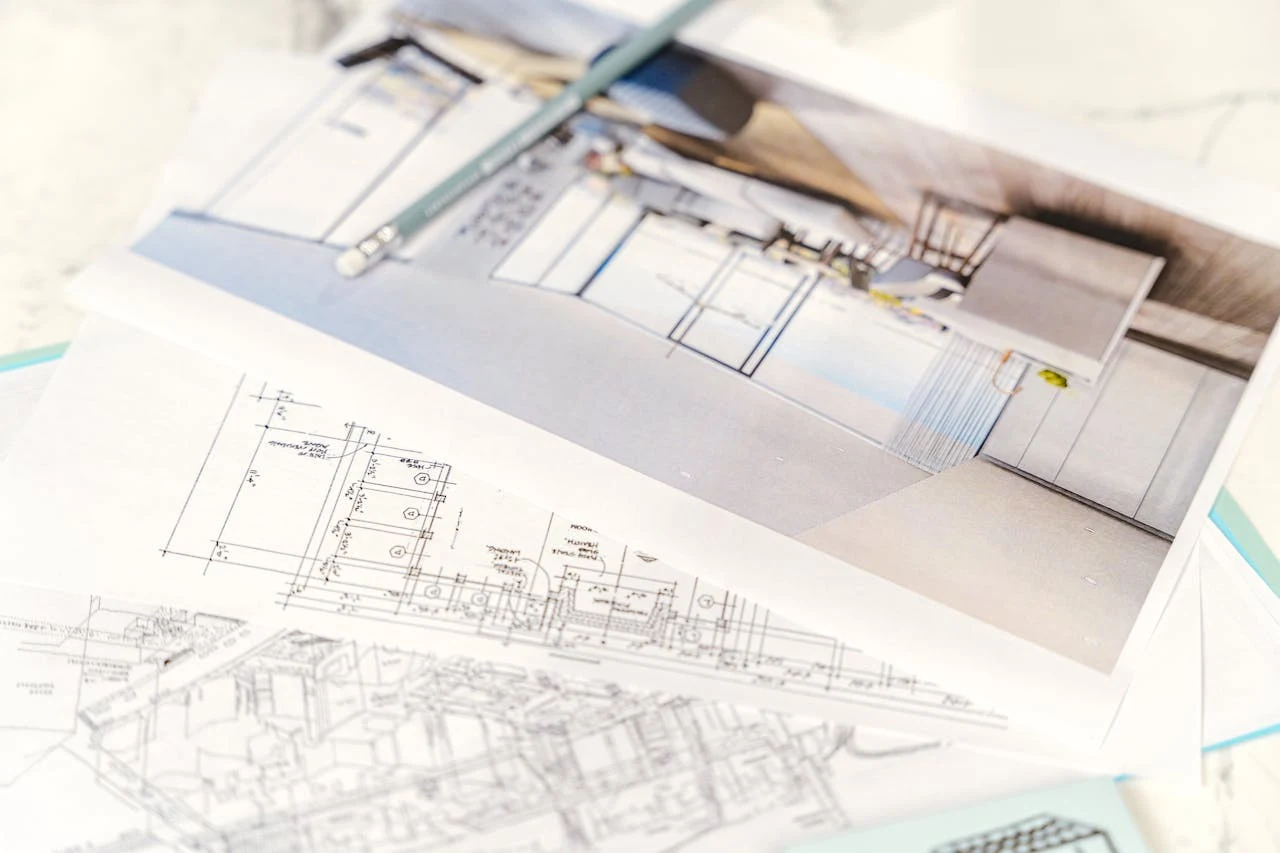Mastering the Architectural Design Process: A Comprehensive Guide
What is Architectural Design?
Have you ever wondered what goes on behind the scenes when an architect designs a building? Or perhaps you're considering a career in architecture and want to know more about what to expect?
This comprehensive guide will break down the architectural design process, from concept sketches to final construction drawings, where creativity meets functionality to shape the spaces we live in. Whether you're an aspiring architect or simply curious about building design, this guide provides a comprehensive look into the intricate world of architecture.
Architectural design goes beyond aesthetics, focusing on solving complex problems and enhancing our surroundings. Architects bring visions to life by organizing space, form, and function in projects ranging from skyscrapers to simple houses.
They blend art and science to leave a lasting impression on the world, shaping spaces that reflect our values, respond to our needs, and improve our everyday experiences in the built environment.
In this comprehensive guide, we've got you covered, since it will demystify the architectural design process and give you a step-by-step study on how architects bring their ideas to life. We'll cover everything in architectural design, where creativity meets functionality to shape the spaces we inhabit.
The Significance of Architectural Design, and Why is it Important?
Architectural design is more than just creating aesthetically pleasing structures; it's about solving complex problems and shaping environments that enhance our lives. From towering skyscrapers to intimate residences, every architectural project begins with a vision brought to life through carefully orchestrating space, form, and function.

Follow the latest developments and news on our Google News website.
Follow Our WebsiteArchitects are the masterminds behind these creations, weaving together art and science to leave a lasting impact on the world around us. Furthermore, the meaning of architectural design lies at the heart of shaping the world we inhabit. It's not merely about creating aesthetically pleasing structures but about crafting spaces that enhance our lives, reflect our values, and respond to our needs. It influences how we experience the built environment, from the homes we live in, to the cities we navigate.
To outline, architectural design is important for several reasons:
- Functionality: It ensures that buildings and spaces are functional and serve their intended purposes efficiently. Good design enhances usability and promotes productivity, comfort, and well-being, whether it's a home, office, school, or public space.
- Aesthetics: Architectural design shapes the visual identity of our surroundings, affecting our perception and emotional response to spaces. Thoughtful design can evoke feelings of inspiration, tranquility, or excitement, enhancing our quality of life and sense of connection to our environment.
 |
| Architecture shapes the visual identity of our surroundings, affecting our perception and emotional response to spaces. Photo by Pixabay |
- Sustainability: In an era of environmental awareness, architectural design plays a crucial role in creating sustainable built environments that minimize resource consumption, reduce waste, and mitigate environmental impact. Sustainable design principles prioritize energy efficiency, using renewable materials, and integrating with natural systems to create healthier and more resilient spaces. Read more...
- Cultural and Social Context: It reflects and responds to cultural values, social dynamics, and historical contexts. It celebrates diversity, fosters inclusivity, and creates spaces that promote community engagement and interaction. By preserving heritage and embracing innovation, architectural design contributes to the richness and diversity of our cultural landscape.
- Economic Impact: It also has significant economic implications, driving investment, tourism, and economic development. Well-designed buildings and public spaces attract businesses, residents, and visitors, contributing to local economies and enhancing property values. Moreover, innovative design solutions can optimize resource allocation, reduce construction costs, and increase long-term operational efficiency.
In brief, architectural design is a powerful tool for shaping the world around us and impacting how we live, work, and interact with our environment. By prioritizing functionality, aesthetics, sustainability, cultural relevance, and economic viability as mentioned above, architects and designers have the opportunity to create spaces that inspire, enrich, and endure for generations to come.
How Do We Start Designing in Architecture?
To embark on the journey of designing in architecture, we first delve into the fundamental question: what purpose does the structure serve? Understanding the essence and function of the building is pivotal in crafting a design that harmonizes with its surroundings and fulfills its intended use.
Research and analysis follow, where we explore contextual factors such as site conditions, cultural influences, and user needs. With a comprehensive understanding in hand, we venture into the conceptual phase, where ideas flow freely, often through sketches, models, or digital renderings.
 |
| It is always a good start with a white paper and a pen which can convert into digital outputs ready for construction. Photo by ANTONI SHKRABA production |
Collaboration among architects, engineers, and clients promotes a dynamic exchange of ideas, refining the vision into a coherent design. Grounded in creativity and rooted in practicality, this initial stage sets the groundwork for the iterative process that lies ahead, where every decision shapes the final outcome of architectural excellence.
Remember, starting in architecture is a continuous learning process. It requires dedication, perseverance, and a passion for design. Embrace the challenges and opportunities that come your way, and always strive to improve your skills and knowledge.
To summarize, review those steps for a safe start in your architectural design process:
- Define the purpose: Understand the intended function and essence of the building.
- Research and analysis: Explore contextual factors including site conditions, cultural influences, and user needs.
- Conceptualization: Generate ideas through sketches, models, or digital renderings.
- Collaboration: Engage in dynamic exchanges with architects, engineers, and clients to refine the vision.
- Creativity meets practicality: Fuse creative concepts with practical considerations to shape the design.
- Iterative process: Embrace an iterative approach where decisions evolve to achieve architectural excellence.
Good luck on your architectural design journey!
What are the 7 Phases of the Architectural Design Process?
We have reached the crux of our discussion, which is no other than the fundamental framework comprising the 7 principal phases inherent to the architectural design process, with each phase serving as an indispensable pillar essential for achieving its ultimate success.
Here are the 7 stages along with detailed explanations for each one:
- 1. Programming: In this initial phase, the designer collaborates closely with the client to determine the project requirements, objectives, and constraints. This involves understanding the purpose of the building, its intended users, spatial needs, budgetary considerations, and any specific functional requirements. The architect conducts interviews, site analysis, and research to gather comprehensive information that will inform the design process.
 |
| The architect collaborates closely with the client to determine the project requirements, objectives, and constraints. Image by Michal Jarmoluk from Pixabay |
- 2. Schematic Design: During this phase, the architect translates the project program into rough sketches and diagrams to explore various design concepts. These sketches typically illustrate the overall layout, spatial relationships, and massing of the building. The focus is on generating creative ideas and exploring different design options while considering factors such as site context, aesthetics, and sustainability principles. The client is involved in reviewing these initial concepts and providing feedback to refine the design direction.
 |
| Starting the schematic design. Photo by Tima Miroshnichenko |
- 3. Design Development: Once a preferred schematic design is selected, the architect begins to develop the design in greater detail. This phase involves refining the architectural concept, establishing the building's structural and spatial organization, and integrating functional requirements. Detailed drawings, plans, sections, and elevations are produced to illustrate the building's design intent, including materials, finishes, and key architectural features. Collaboration with engineers and other consultants intensifies during this phase to ensure technical feasibility and compliance with building codes and regulations.
 |
| Detailed drawings, plans, sections, and elevations are produced to illustrate the building's design objective. Photo by Yan Krukau |
- 4. Construction Documents: In this phase, the design is further developed into comprehensive construction documents that serve as the legal and technical basis for building construction. These documents include detailed drawings, specifications, and schedules that provide instructions for contractors to execute the design accurately. The architect coordinates with consultants and reviews the documents to ensure consistency, accuracy, and compliance with project requirements and regulatory standards. Read more...
- 5. Bidding and Negotiation: Once the construction documents are complete, the architect assists the client in soliciting bids from contractors for the construction of the project. This involves preparing bid packages, issuing invitations to bid, and conducting pre-bid meetings. The architect also evaluates the bids received, clarifies any questions from bidders, and negotiates contracts with the selected contractor on behalf of the client.
- 6. Construction Administration: During the construction phase, the architect serves as the client's representative to oversee the implementation of the design and ensure that the construction work conforms to the contract documents. This involves conducting regular site visits, reviewing shop drawings and samples, resolving construction issues, and administering change orders as necessary. The architect also facilitates communication between the client, contractor, and other project stakeholders to address any challenges and ensure the successful completion of the project.
- 7. Post-Occupancy Evaluation: After the building is occupied, the architect conducts a post-occupancy evaluation to assess how well the design meets the client's objectives and the users' needs. This may involve gathering feedback from occupants, monitoring the building's performance in terms of functionality, comfort, and energy efficiency, and identifying any areas for improvement. The findings from this evaluation can inform future design projects and contribute to the architect's ongoing professional development.
- The completion of the final stage may vary depending on the workflow and the level of satisfaction from both the client and the contractor or on the local rules embraced.
.png)







